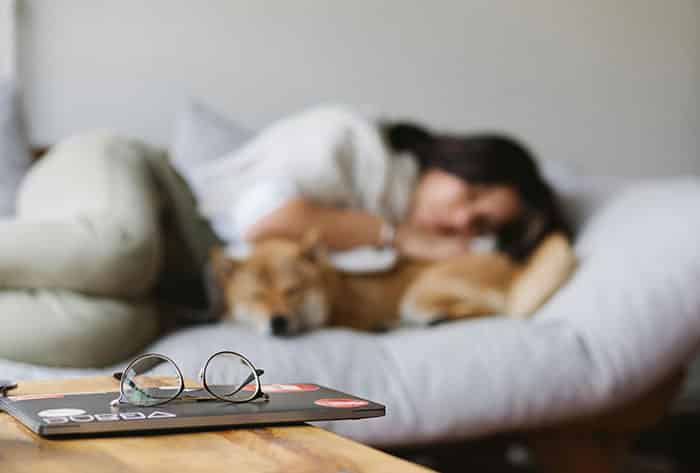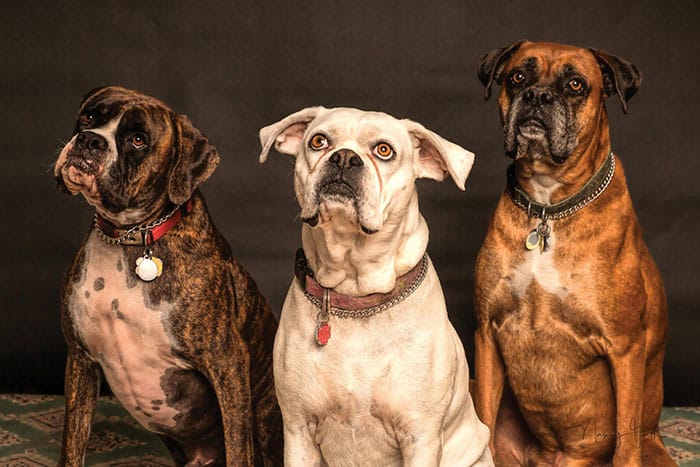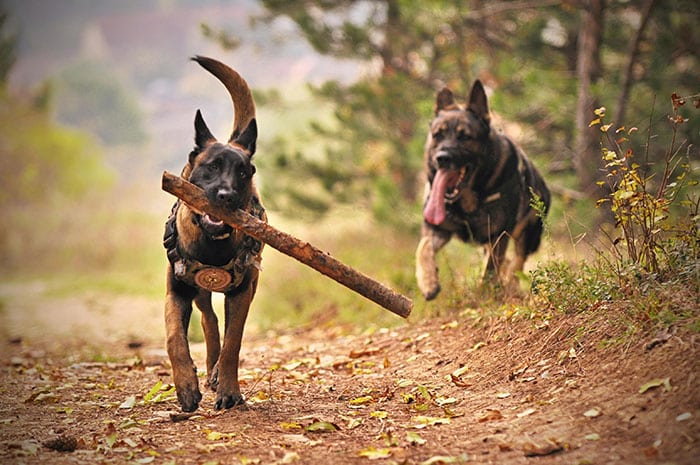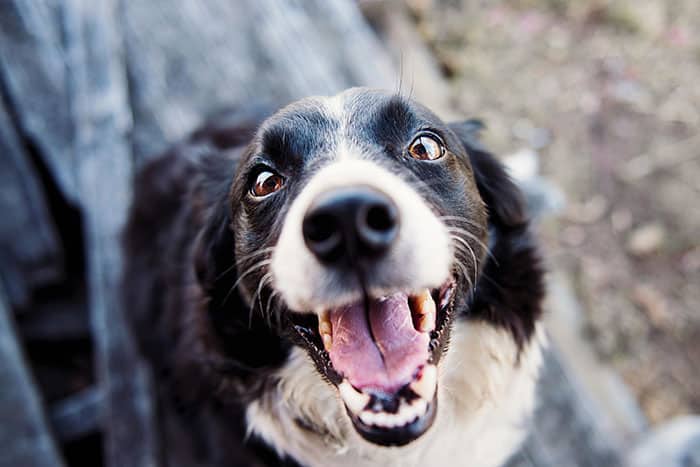Dogs might seem to have the perfect life: playing, eating, and snoozing whenever they please. But just like us humans, dogs rely on quality sleep to stay healthy, happy, and well-behaved.

By understanding how much sleep your dog needs, what affects their rest, and the type of environments that can improve it, you can make a big difference in their overall health and well-being.
How Many Hours a Day Do Dogs Sleep?
Most dogs sleep far more than humans; typically between 10 and 14 hours a day. However, their exact sleep needs depend on various factors, including age, breed, activity level, and environment.
- Puppies sleep the most, often up to 18-20 hours per day, since their bodies and brains are developing rapidly.
- Adult dogs typically sleep for 10-12 hours daily, with most of their sleep occurring at night and shorter naps throughout the day.
- Senior dogs tend to nap more frequently and may sleep up to 16 hours or more due to reduced energy and mobility.
Highly active breeds, such as Border Collies or Huskies, may require less downtime, while large breeds like Mastiffs or Great Danes are natural champions of napping.

Signs Your Dog Isn’t Sleeping Enough
Dogs are adaptable, but sustained sleep deprivation can impact their health and temperament, so it’s essential to monitor their sleep habits to ensure their overall well-being. Some common signs that your dog may not be getting the rest they need:
- Increased irritability or anxiety
- Difficulty focusing or responding to commands
- Excessive yawning or pacing
- Lethargy or low energy despite an adequate diet and exercise
- Restless nights or frequent repositioning
If your dog displays these patterns and seems on edge or unusually tired, it may be time to assess their sleeping habits and environment.

Can Dogs Have Sleep Disorders?
Yes. While less common than in humans, dogs can suffer from sleep-related issues. The most frequent include:
- Narcolepsy: A neurological condition that causes sudden sleep attacks or muscle weakness, often triggered by excitement or play. It’s more common in breeds like Labrador Retrievers and Dobermans.
- Obstructive Sleep Apnea: Seen mostly in flat-faced breeds (like Bulldogs or Pugs), this disorder causes temporary breathing pauses during sleep, often accompanied by loud snoring. Weight management and, in some cases, surgery can help.
- REM Sleep Behavior Disorder: Dogs may “act out” their dreams by barking, growling, or moving violently during REM sleep. Medication or behavior management can help minimize symptoms.
If you suspect a sleep disorder, consult a veterinarian for diagnosis and treatment. Many issues can be managed with lifestyle adjustments or targeted therapy.

How to Help Your Dog Sleep Better
Even healthy dogs can benefit from an optimized sleep routine. A few simple changes can make all the difference:
1. Create a Comfortable Sleeping Area
Select a supportive and cozy dog bed that suits your dog’s age and size. Orthopedic or memory foam beds are ideal for older dogs with joint issues. Keep the area quiet, dark, and draft-free to encourage deep rest.
2. Establish a Consistent Routine
Dogs thrive on predictability. Feeding, walking, and bedtime should follow a regular schedule. This helps regulate their internal clock, making it easier for them to wind down at night.
3. Encourage Daily Exercise
A tired dog is a happy sleeper. Regular walks and playtime help expend energy and reduce anxiety. Also, avoid overly stimulating activities right before bedtime – opt for calm, low-key interactions instead.

4. Limit Nighttime Disruptions
While some owners love sharing a bed with their dogs, co-sleeping can interrupt both your sleep cycles. If your dog tosses and turns or snores loudly, consider giving them their own bed nearby.
5. Keep Things Calm and Familiar
Avoid sudden noises or changes in light at night. Dogs are sensitive to their environment, and a peaceful, consistent setting goes a long way to promote better, uninterrupted rest.
Getting Your Puppy on a Healthy Sleeping Schedule
Puppies are bundles of energy who need plenty of sleep to grow, and providing structure for them can help them settle into a healthy routine.
- Designate a Sleeping Space: A crate or small enclosed area helps puppies feel safe and signals it’s time to rest. Add a soft blanket and a comfort item that smells like you.
- Stick to a Bedtime Routine: Feed dinner a few hours before bed, take them for one last potty break, then quiet play or cuddles before lights out.
- Ignore Attention-Seeking Whines: If your puppy has been fed and gone potty but still seems restless, gently reassure them without removing them from the crate. They’ll learn nighttime means sleep, not playtime.
- Expect Nighttime Breaks: Young puppies may need to go outside for bathroom trips every few hours until they develop bladder control. Keep these brief and calm. No play, just business.

Patience in this area will pay off. Within a few weeks, most puppies adapt to their owners’ sleep schedule and begin resting through the night.
Helping Your Rescue Dog Get Better Sleep
Adopted dogs often face unique sleep challenges as they adjust to a new home. Stress, unfamiliar sounds, or changes in routine can make it difficult for them to relax. To help them adapt and get as much rest as possible, you can:
- Keep the First Few Days Quiet: Limit visitors and loud noises while your new dog adjusts to its surroundings. Too much stimulation early on can contribute to anxiety.
- Offer Multiple Resting Options: Some rescue dogs prefer open beds, while others feel secure in a crate. Let them choose where they’re most comfortable.
- Sleep Nearby Initially: Spending the first night or two close to your rescue dog can reassure them they’re safe. Gradually move back to your routine as they relax.
- Watch for Overstimulation: Rescue dogs may sleep more at first as a way to recover from the stress of their previous environment. Ensure they have at least 10-12 hours of sleep and several hours of daytime rest.
- Introduce Structure Slowly: Once your rescue is sleeping soundly, you can begin consistent feeding, walking, and training schedules.

Patience and predictability are key. A well-rested rescue dog is more confident, responsive, and emotionally balanced.
Wrapping Up
Healthy sleep is as vital for dogs as it is for humans. From playful puppies to senior companions, every dog benefits from a stable routine, a peaceful environment, and plenty of rest.
Paying attention to your pet’s sleep patterns isn’t just about comfort; it will help support their physical health, emotional well-being, and overall happiness.
Additional Resources
- Why Do Dogs Sleep So Much?
- Understanding Your Dog’s Sleeping Patterns
- Rest Easy: Getting the Facts on Pet Safety and Sleep Aids
- Dog Owners and Preventive Healthcare
- Canine Preventive Healthcare Guidelines
- Behavioral Changes in Senior Dogs
- Canine-Human Mental Health Connection
- Adult Dogs Sleep Study
- Narcolepsy in Labrador Retrievers
- Sleeping Disorders in Animals
- A Vet’s Views on Sleeping with Dogs
- Insomnia in Senior Dogs
- Senior Dog Dementia and Altered Sleep Patterns
- Why Dogs Don’t Sleep at Night
- Why Does My Dog Move While Sleeping


